|
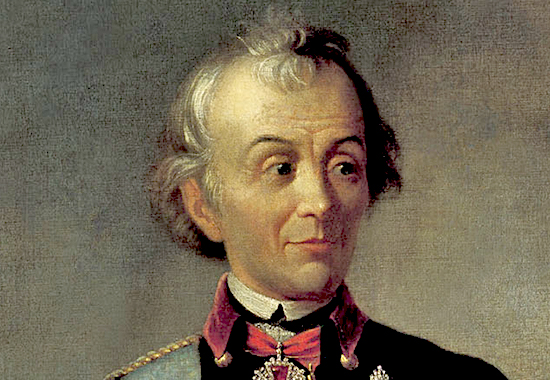
Aleksandr Vasilyevich Suvorov
1729-1800
Russia's Excellent Generalissimo
Suvorov was born in Moscow and died in Saint
Petersburg. Today, both cities host a Suvorov
Military Academy, named after this fine military commander.
|
|
All in all, Suvorov Military
Schools exist in about a dozen cities.
Image Above
Aleksander V.
Suvorov
Oil on canvas by
unknown artist. Scroll down to see the entire
painting.
Source uncertain |
Suvorov was a masterful leader who understood brilliantly
how to blend military discipline with an appreciation of
human nature and common sense.
In practice, this meant
"Money is dear. Human
life is still dearer. But time is the dearest of all."
A.V. Suvorov
As a commander,
Suvorov is said to have fought more than 60 battles without losing a single one of them.
Suvorov's average, and sometimes
ridiculed, physique and facial appearance seem irrelevant considering
his remarkable characteristics — his thirst for knowledge, his
intelligence, his interest in military history, his genuine
respect for the soldier (friend or enemy), and his
occasional eccentricity.
Alexandr V. Suvorov's
Family
In Moscow on January 16, 1774, Suvorov
married Varvara Ivanovna
Prozorovskaya. This unhappy marriage was
over by the year 1784.
Aleksandr and Varvara had two
children. A son, Arkady,
and a daughter, Natalya.
Suvorov accepted Natalya as his child, but not Arkady.
Seven Years' War
1756-1763
Suvorov gained his first combat
experience in the
 Seven Years' War.
Seven Years' War.
On August 25, 1758, a
twenty-eight year-old Suvorov participated in the
Battle of Zorndorf where
he witnessed a forty-six year-old
 Frederick II the Great
on his way to Prussian victory.
Frederick II the Great
on his way to Prussian victory.
In 1762, Suvorov was promoted to
colonel.
Russo-Turkish
War of 1787
Suvorov fought in the
 Russo-Turkish War of 1787-1791
with mixed results.
Russo-Turkish War of 1787-1791
with mixed results.
After his success at the
Battle of Kinburn on
October 10, 1787, Suvorov hastily engaged with the enemy at
the Siege of Ochakov in
1788. This cost him 200 men, prompted a rebuke by his
commander-in-chief, Grigory A.
Potemkin, and left Suvorov himself wounded.
Eventually, however, on December 17, 1788, Ochakov was taken
by the Russians.
At the
Battle of Focsani,
today's Foçsani in Romania, which was fought on July 30,
1789, and with the help of Austria's
 Frederick Josias of
Saxe-Coburg-Saalfeld, Suvorov booked a
Russian victory. Frederick Josias of
Saxe-Coburg-Saalfeld, Suvorov booked a
Russian victory.
On September 22, 1789, Suvorov
and Saxe-Coburg fought the Battle
of the Rimnik, also called and spelled Battle
on the Rimnic River or Rimniki, or Rymnik. Suvorov's enemy
outnumbered him four to one. But Suvorov liked himself a
surprise attack. He won the battle.
For this triumph, Catherine II
henceforth called him Count Rimniksky. Austria's
 Joseph II followed suit
by making Suvorov Reichsgraf (count) of the Holy
Roman Empire, which was nothing to sneeze at either. Joseph II followed suit
by making Suvorov Reichsgraf (count) of the Holy
Roman Empire, which was nothing to sneeze at either.
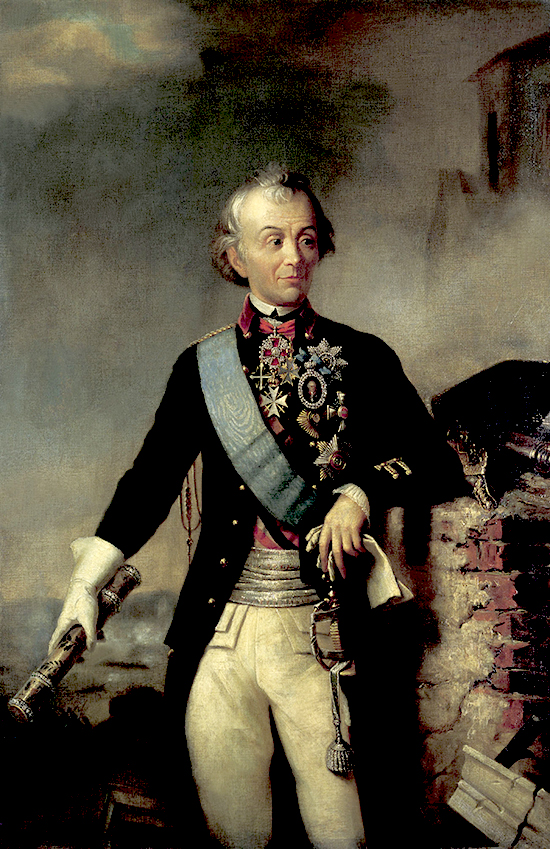
Russian General Aleksandr V. Suvorov
1729-1800
Painter / Source
Unknown
French
Revolutionary Wars 1792-1802
The
 French Revolutionary Wars started in 1792
with the
French Revolutionary Wars started in 1792
with the
 War of the First Coalition.
France won that war in 1797.
War of the First Coalition.
France won that war in 1797.
Russia was not a member of the
First Coalition against France.
While the War of the First
Coalition was fought,
 Empress Catherine II the Great sent
Suvorov to defeat revolutionary Poles in their
homeland. Suvorov fought well and was promoted to field
marshal.
Empress Catherine II the Great sent
Suvorov to defeat revolutionary Poles in their
homeland. Suvorov fought well and was promoted to field
marshal.
Catherine II died on November 6, 1796. Against Catherine's will, her
ridiculous son
 Paul became her
successor.
Paul became her
successor.
Czar Paul and Field Marshal
Suvorov had very different views regarding military matters.
The latter was an expert, the former a fool. Suvorov decided
therefore to resign while, almost
simultaneously, Paul decreed that Suvorov should retire. At
least it was mutual.
Back to the French Revolutionary
Wars.
In November 1798, the
 War of the Second Coalition
broke out. This time Russia joined the
Coalition.
War of the Second Coalition
broke out. This time Russia joined the
Coalition.
In February 1799, Czar Paul
yanked Suvorov out of retirement. The experienced commander was put in charge of
an Austro-Russian army. His task was to get the French out
of Italy.
On April 27,
1799, Suvorov won the
Battle of Cassano (Cassano
d'Adda) and then entered Milan.
Before
engaging with the enemy, he explained to his
soldiers how thorough he expected them to
be:
"Pursue
the last man to the Adda and throw the
remains into the river."
Check this event in the
 French
Revolutionary Wars Timeline. French
Revolutionary Wars Timeline.
On June 19, 1799, Suvorov won the
Battle of Trebbia
(also Battle of Trebia).
Check this event in the
 French Revolutionary Wars
Timeline.
French Revolutionary Wars
Timeline.
On August 15, 1799, Suvorov won the
Battle of Novi
(Novi Ligure), for which he was awarded the
title Knyaz Italiysky or Prince of
Italy (some translate it with Count
of Italy or Duke of Italy).
Check this event in the
 French Revolutionary Wars
Timeline.
French Revolutionary Wars
Timeline.
After the Battle of Novi, Suvorov prepared
to continue west and march into France.
However, he received orders to leave his
Austrian troops in Italy and to take his
20,000 Russian troops into Switzerland,
where he was to reinforce Russian General
Aleksandr
Rimsky-Korsakov, who was
threatened by a French army.
Following orders, Suvorov and his men fought their way
across the Alps, all the way to Altdorf,
which is located in central Switzerland
(then Helvetic
Republic) and, incidentally, the
very place where
William Tell took a crossbow and
shot an apple off his son's head.
Arriving at Altdorf,
Suvorov found himself only a few miles away from French
General Massena,
who just had had Rimsky-Korsakov's army for
breakfast at Zurich on September 25, 1799.
(See
 Second
Battle of Zurich) Second
Battle of Zurich)
Suvorov was
surrounded.
He managed to
break out of the encirclement, to reach
Glarus (see Linth River on the map below),
and to finally fight off the French tail.
By October
1799, Suvorov had himself and 15,000 of his
men safely in Austria where they could at
last reunite with Rimsky-Korsakov and,
together, buy
some candles for Suvorov's 70s birthday
(November 24, 1799).
And here is
the map:
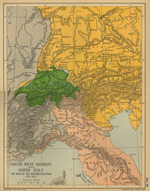
Map of the War of the Second Coalition 1798-1801
For his remarkable
performance in 1799, Suvorov was promoted to
generalissimo, Russia's highest
military rank. Now, Suvorov had to answer to no
one with the regrettable exception of Czar Paul.
Knowing that he
had beaten the French but had not finished them
off, Suvorov correctly predicted a French
revitalization. He was ready to dive right back
into the turmoil of war. But in January 1800 he
was ordered to
return to St. Petersburg, where he arrived on April
20, 1800.
Back at home, and expecting to receive
at least a warm handshake and a Thank You from his sovereign,
Suvorov learned that he was not allowed to come
anywhere near the Czar. Paul had banned Suvorov from the
palace.
Suvorov died at St.
Petersburg on
May 18, 1800.
Paul was
assassinated in March 1801, and the
War of the Second Coalition ended in 1802.
France won once again.
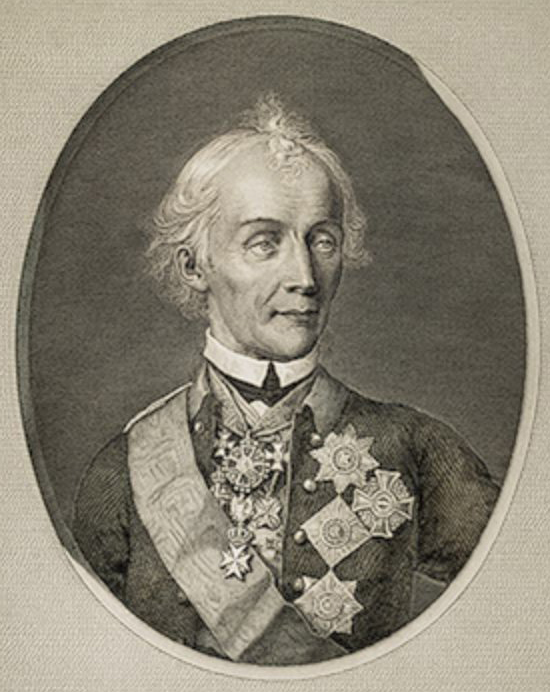
Portrait of Alexander Suvorov
Line Engraving by
Nikolai Ivanovich Utkin in 1818
State Hermitage Museum
Suvorov's Secret
to Military Success
Suvorov assembled his thoughts
on the subject on paper, a work that we know as Suvorov's
Art of Victory. Originally just a manuscript, Suvorov
finished it in 1796. There it was — years of precious experience
in a nutshell.
Later, even
 Lenin thought
that Suvorov's manuscript was exactly what the medic ordered
and included it as part of the Handbook of the Red Army
Soldier.
Lenin thought
that Suvorov's manuscript was exactly what the medic ordered
and included it as part of the Handbook of the Red Army
Soldier.
What did Suvorov recommend?
Training and speed. Dr. Bruce W.
Menning explains:
[...]
Suvorov’s stress on thorough preparation and
speedy execution was sufficient to produce
threescore major and minor victories, often
in the face of hopeless odds.
As Philip
Longworth, Suvorov's most recent Western
biographer, has noted, "he won far too
frequently to be called lucky: he never
lost."
Read Menning's
fine article
 Train Hard, Fight
Easy: the Legacy of A. V. Suvorov and His
"Art of Victory"
Train Hard, Fight
Easy: the Legacy of A. V. Suvorov and His
"Art of Victory"
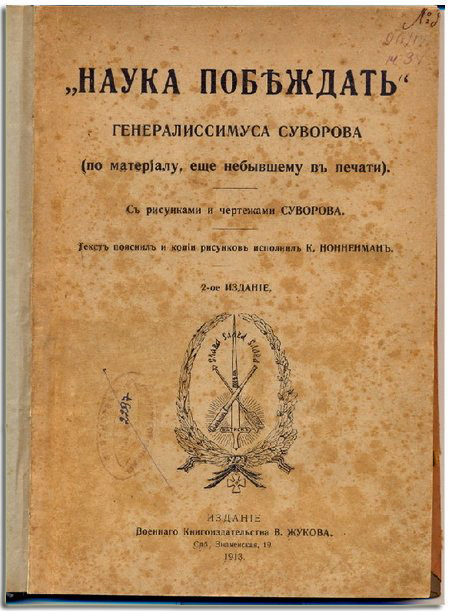
The Art of Victory (in
Russian: Nauka pobezhdat'
or
Наука побеждать,
literally The Science of Winning) —
Also called Surorov's
Catechism for the Soldier
A 1913 Edition. Wiki.
Suvorov was rarely taken by surprise,
thanks to his enormous emphasis on exercise and preparation. Instead, he always sought to
catch his enemy unawares.
In his Art of Victory,
Suvorov boils his strategy down to these three fundamental rules:
Глазомер,
быстрота, натиск
in other words:
Look sharp. Move
fast. Hit hard.
(The literal translation would
read Accurate eye, speed, attack. Thank you, Rachel
Douglas, for your expertise.)
Suvorov's Legacy
In addition to the above
mentioned Suvorov Military Academies, Suvorov's name lived
on in other places.
A 335-tonner, the Russian ship
Suvorov, visited Sydney, Australia, in August /
September 1814. Owner of the ship was the
Russian-American Company,
a Russian trading monopolist. Commander of the vessel was
Mikhail Petrovich Lazarev,
who was on his way to Alaska on business.
From Sydney, the Suvorov
continued her voyage north and sighted — and named — today's
Suwarrow Atoll, part of
the Cook Islands in the South Pacific Ocean.
What happened to the spelling?
In his 1819 poem Don Juan,
Lord Byron refers to Suvorov's
Siege of Ismail in 1790. Here's a passage:
'Fierce
loves and faithless wars'—I am not sure
If this be the right reading—'t is no
matter;
The fact 's about the same, I am secure;
I sing them both, and am about to batter
A town which did a famous siege endure,
And was beleaguer'd both by land and
water
By Souvaroff, or Anglice Suwarrow,
Who loved blood as an alderman loves
marrow.
Hence, the Cook Islands
Government calls it the Suwarrow Atoll, not the Suvorov
Atoll. Some prefer a compromise and call it Suvarov Atoll.
Take your pick.
An atoll, by the way, is a ring
of coral reef draped around the top of a sunken and
completely submerged volcanic island. If the tip of the dormant
volcano is still sticking out, it's a reef.
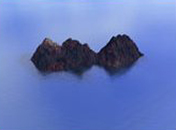 |
 |
 |
|
Volcanic Island |
Reef |
Atoll |
Robert Simmon, NASA GSFC |
Today, the Suwarrow Atoll is
uninhabited.

Map Location Cook Islands
Government of the Cook
Islands
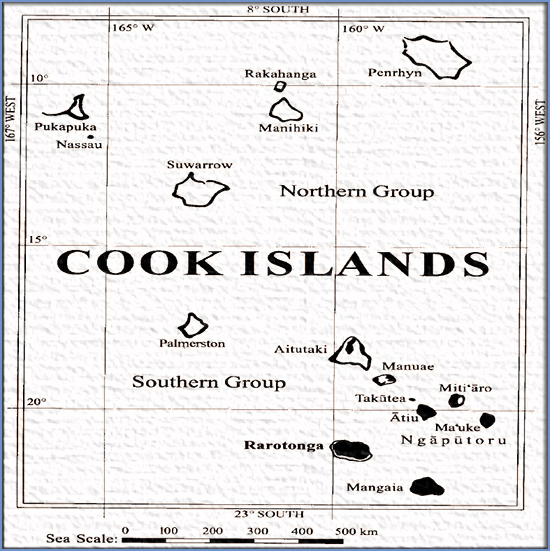
Map Location Suwarrow Atoll, Cook
Islands
Ministry of Finance and
Economic Management, Statistics Office, Cook Islands
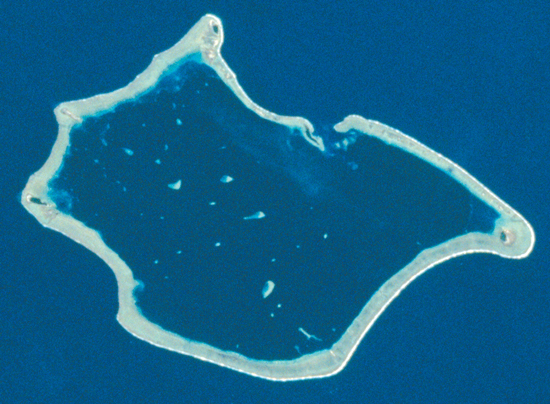
Suwarrow Atoll, Cook Islands
Earth Sciences and
Image Analysis Laboratory, NASA, Johnson Space Center
More Suvorov
The Japanese sunk the Russian
battleship Prince
Suvorov (Князь Суворов) on May 27, 1905, at the
Battle of Tsushima,
which was part of the
 Russo-Japanese War.
Russo-Japanese War.
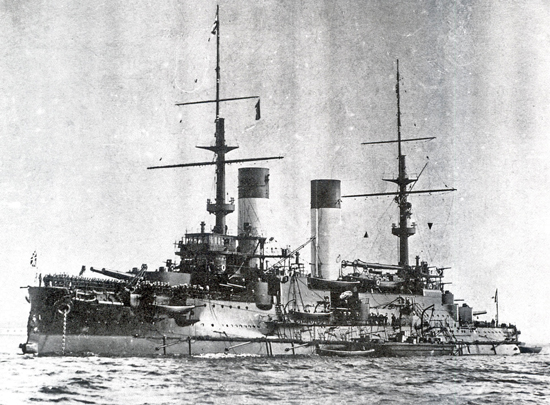
Imperial Russian Battleship Knyaz
Suvorov at Kronshtadt Harbor,
northwestern Russia, August 1904
Photo: Wiki
In January 1941, the Russian movie
Suvorov (Russian spelling: Суворов) was released — officially a Suvorov documentary,
unofficially a courage fluffer. And rightly so. In June 1941, the Germans
invaded the Soviet Union.
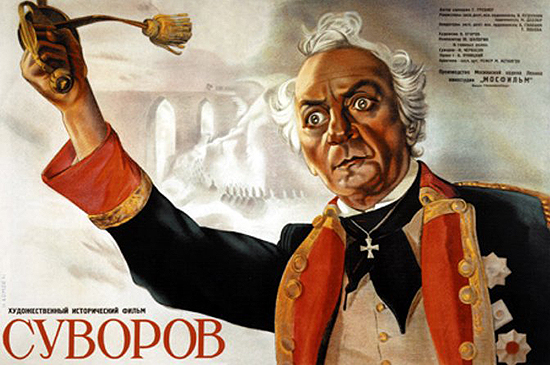
Suvorov — The Movie
Image: Wiki
On September 30, 1942, the USSR
Supreme Soviet Presidium passed a resolution to manufacture
a shiny medal, the
Order of Suvorov,
which would be bestowed to award outstanding military
achievements by senior officers.
The Soviet Union decided
 Dwight D. Eisenhower
qualified because of his accomplishments in
Dwight D. Eisenhower
qualified because of his accomplishments in
 World War
II. And, on February 19,
1944, they gave him one of their highest service
decorations, the Order of Suvorov, First Class.
World War
II. And, on February 19,
1944, they gave him one of their highest service
decorations, the Order of Suvorov, First Class.
British
Admiral Sir Bruce Austin Fraser had one as
well in his cupboard. He earned his on December 26, 1943,
when, aboard his battleship, the Duke of York, he led
his fleet to sink the German battle cruiser Scharnhorst.
Here is the good piece:
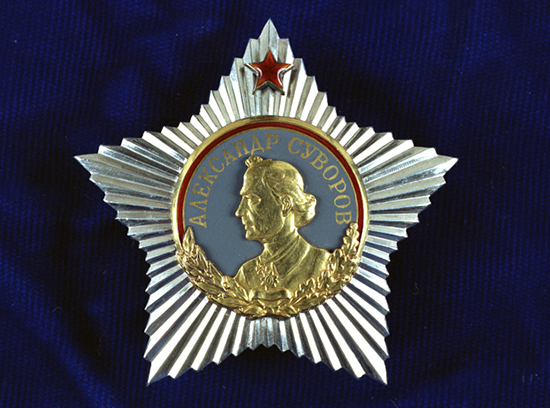
Order of Suvorov, First Class
Dwight D. Eisenhower
Presidential Library and Museum
Carrying the Suvorov name less successfully, was the modern Soviet four-deck river cruise
ship Alexandr Suvorov. On June 5, 1983, it rammed a
railway bridge over the Volga near Ulyanovsk, at the exact
same time when a freight train was crossing the bridge.
It was chopped to a three-decker and nearly 200 people died.
Suvorov Trivia
Suvorov referred to his
soldiers' heavy backpacks with the Russian word ветры,
which is the plural of ветер, meaning wind or
breeze. Thus, with a witty remark and some
psychological insight, Suvorov lightened his soldiers'
burdens.
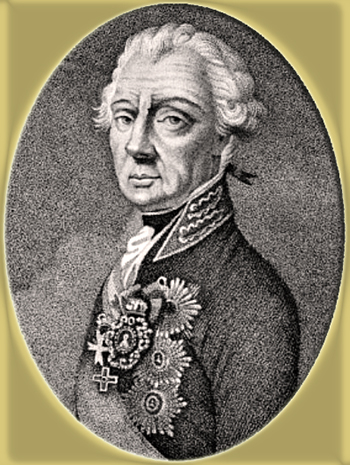
Aleksandr Vasilevich Suvorov
Engraving by T. Clarke,
Library of Congress
Read Suvorov
Here you can read Suvorov's
 Art of Victory (НАУКА ПОБЕЖДАТЬ)
in Russian, provided by the Library of the
Russian People.
Art of Victory (НАУКА ПОБЕЖДАТЬ)
in Russian, provided by the Library of the
Russian People.
Here are
 his letters from the same
source and also in Russian.
his letters from the same
source and also in Russian.
More History
|